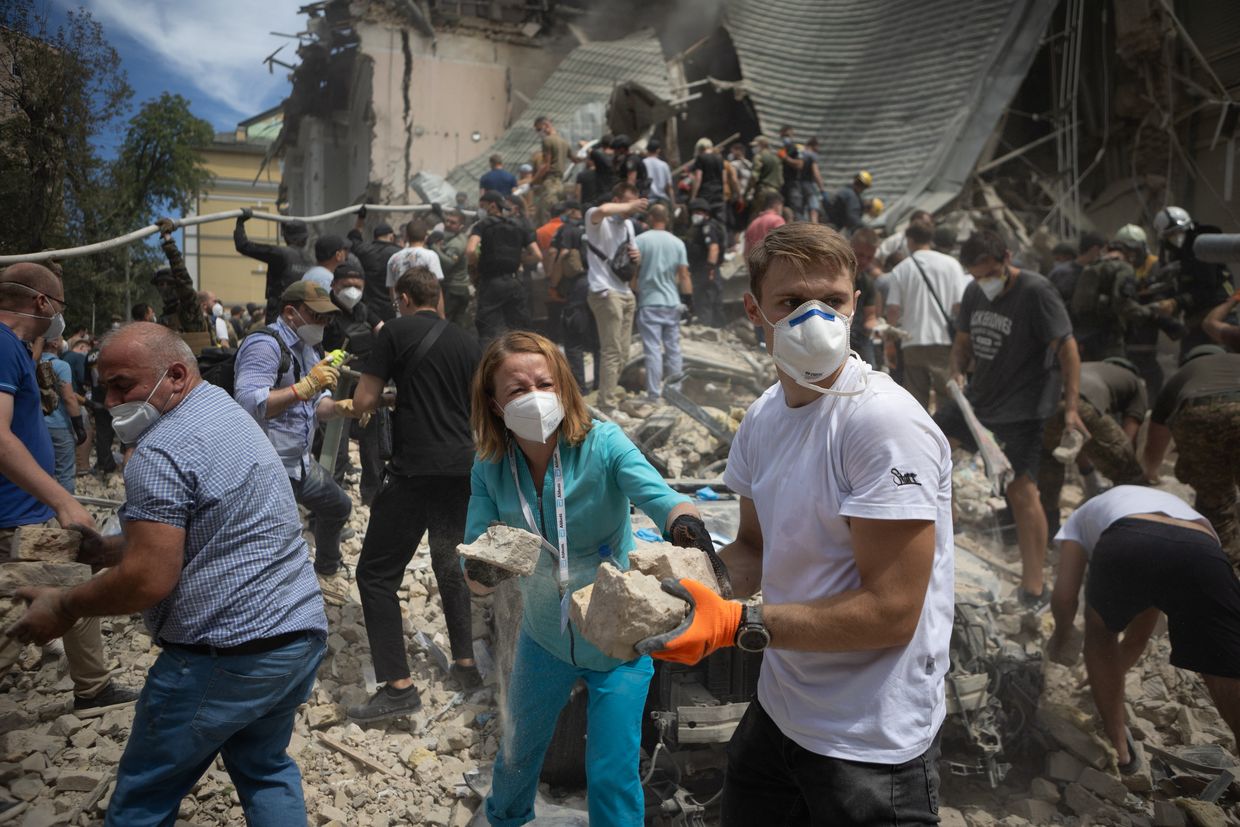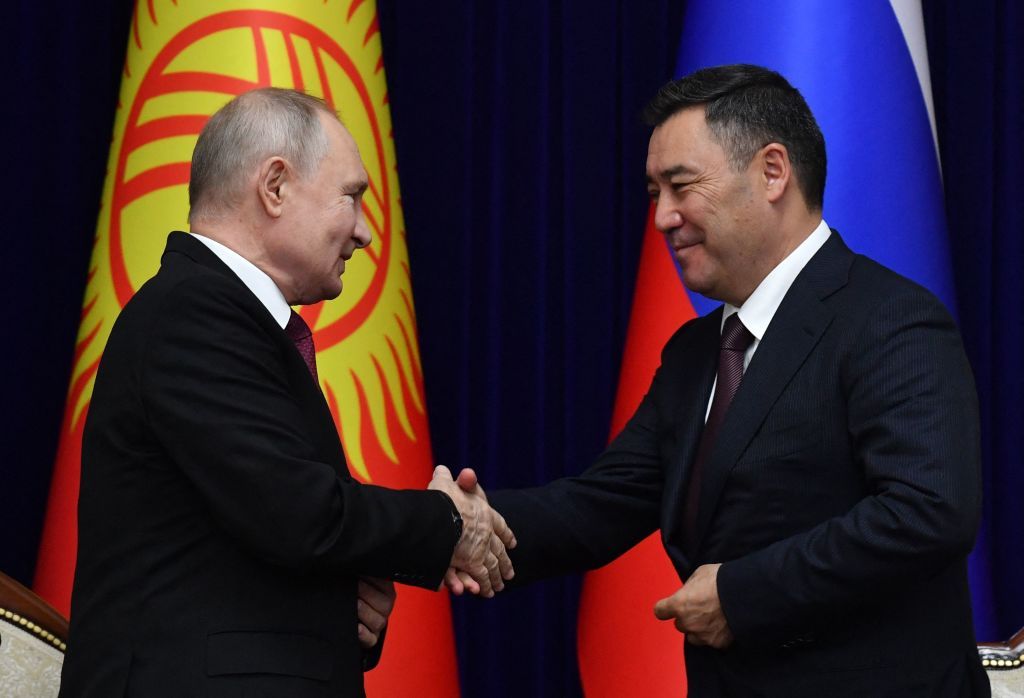
Opinion: Russian Kh-101 missile with US components continues killing Ukrainians en masse
People clear rubble from a building of one of the largest children’s hospitals of Ukraine, ‘Okhmatdyt’, partially destroyed by a Russian missile strike in Kyiv, Ukraine on July 8, 2024. (Valentyna Polishchuk/Global Images Ukraine via Getty Images)

Olena Tregub
Forensic experts identified Kh-101 missile fragments at the Okhmatdyt children’s hospital, one of the sites of Russia’s mass attack on July 8, which killed 33 people in Kyiv, including five children. The Kh-101, a strategic air-to-ground cruise missile, is among the most destructive in Russia’s arsenal.
First used by Russia in the Syrian civil war, the weapon is now being used against targets in Ukraine, both military and civilian.
The Kh-101 is Russia’s most modern missile, with a high-precision accuracy range of 5-6 meters and the ability to change its trajectory mid-flight. Russia’s demand for this missile is evident from the increase in its production from 56 in 2021 to 420 in 2023.
While Russian officials claim the Kh-101 is made entirely of Russian components, research by the Independent Anti-Corruption Commission (NAKO) and our partners reveals that many critical foreign components are present in this and other Russian missiles.
According to the Financial Times, based on an analysis by Ukraine’s President's Office, the Kh-101 that struck Okhmatdyt likely contained over 50 parts of Western origin.
Information about foreign components in Russian missiles surfaced as early as 2022. The Royal United Services Institute (RUSI) examined 27 different weapon systems and identified 450 unique components, mainly sourced from Western manufacturers, with at least 318 originating from U.S. firms. At the time of the study and the production of the examined missiles, “grey import” was not yet a significant issue.
The Kh-101 contains satellite navigation systems, a receiver block, a processor module, and a computing block, all with substantial microelectronics manufactured in the West, specifically in the U.S., the Netherlands, Switzerland, and Taiwan. These include microchips, microprocessors, and memory modules. For instance, components made by the American chip and semiconductor manufacturer Texas Instruments have been found within the processor module of the Kh-101. These parts literally guide the missile to its target – in this case, a busy children’s hospital in the center of Kyiv.
Since the start of the full-scale invasion, over 70 instances of airstrikes using the Kh-101 have been recorded in Ukraine. NAKO and the International Partnership for Human Rights (IPHR) studied mass attacks using this weapon in 2022 as part of the report "Enabling War Crimes? Western-Made Components in Russia's War Against Ukraine."
These attacks included strikes on a residential building in Odesa, the shelling of Thermal Power Plant-Five (TPP-5) near Kharkiv, and missiles hitting the popular Glass Bridge in Kyiv.

NAKO experts published a list of Western components in the Kh-101 and other weapons in both 2022 and 2023, identifying 24 components made by the American chip manufacturer Maxim Integrated and products from the American semiconductor manufacturer Cypress Semiconductor.
These findings underscore the dependency of Russian military systems on Western microelectronics, which are integral to their functionality. The problem is systemic. Despite international sanctions and export controls, Western parts continue to find their way into Russia.
Russia is willing to pay any price for these components, mainly buying not directly from manufacturers but through intermediaries in various countries.
Microelectronics manufacturers are required to adhere to sanction and export requirements. However, in practice, it is almost impossible to fully implement these restrictions, especially with the involvement of “grey import” countries and cycles of redistribution from company to company and country to country. American and European manufacturers do not control the movement of their microelectronics once they are resold.
Western partners regularly impose sanctions on intermediary companies supplying microelectronics to Russia. However, for every sanctioned Chinese company, three new ones may appear in Hong Kong, Thailand, or Kyrgyzstan. Thus, sanction policies need solutions affecting specific business sectors and financial institutions in such exporting countries.
It’s not enough to implement sanctions; it’s necessary to closely monitor their compliance, track the supply chains used by Russia, and constantly update sanction policies to maintain their effectiveness. Ukraine is taking steps in this direction: President Volodymyr Zelensky raised the issue of Western components in Russian missiles at the recent NATO summit in Washington. Hopefully, the message did not fall on deaf ears.
While Ukrainians are all too familiar with the devastating sound of Kh-101 missiles, they are also beginning to recognize the Western firms enabling Russia's destruction. These companies must prove they are doing everything possible to prevent their technology from being imported by the Russian war machine. Otherwise, they and their shareholders will be held accountable for the destruction caused by their disregard for trade sanctions.
Western governments and regulators must enforce stricter component tracking to ensure corporate responsibility includes criminal and financial accountability. Manufacturers should be held to the same standards as banks. Stricter penalties for failing to identify Russia as the end-user will push companies to improve their due diligence.
As the West remains passive, Russia’s allies gain experience for future conflicts. Tightening sanctions can stop the flow of components to Russia and its allies—but does the West have the will to do so?
Editor’s Note: The opinions expressed in the op-ed section are those of the authors and do not purport to reflect the views of the Kyiv Independent.











